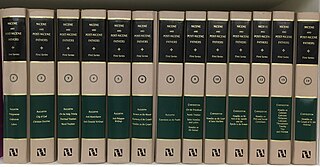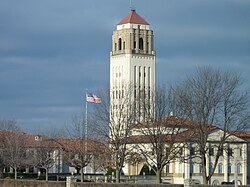Pentecostalism or classical Pentecostalism is a Protestant Charismatic Christian movement that emphasizes direct personal experience of God through baptism with the Holy Spirit. The term Pentecostal is derived from Pentecost, an event that commemorates the descent of the Holy Spirit upon the Apostles and other followers of Jesus Christ while they were in Jerusalem celebrating the Feast of Weeks, as described in the Acts of the Apostles.

Christian Science is a set of beliefs and practices which are associated with members of the Church of Christ, Scientist. Adherents are commonly known as Christian Scientists or students of Christian Science, and the church is sometimes informally known as the Christian Science church. It was founded in 1879 in New England by Mary Baker Eddy, who wrote the 1875 book Science and Health with Key to the Scriptures, which outlined the theology of Christian Science. The book became Christian Science's central text, along with the Bible, and by 2001 had sold over nine million copies.
The doctrine or theory of immanence holds that the divine encompasses or is manifested in the material world. It is held by some philosophical and metaphysical theories of divine presence. Immanence is usually applied in monotheistic, pantheistic, pandeistic, or panentheistic faiths to suggest that the spiritual world permeates the mundane. It is often contrasted with theories of transcendence, in which the divine is seen to be outside the material world.
The Latter Rain, also known as the New Order or the New Order of the Latter Rain, was a post–World War II movement within Pentecostal Christianity which remains controversial. The movement saw itself as a continuation of the restorationism of early pentecostalism. The movement began with major revivals between 1948 and 1952 and became established as a large semi-organized movement by 1952. It continued into the 1960s. The movement had a profound impact on subsequent movements as its participants dispersed throughout the broader charismatic and pentecostal movements beginning in the 1960s.
Word of Faith is a movement within charismatic Christianity which teaches that those who believe in Jesus' death and resurrection have the right to physical health, that words have power, and that true faith is more than simply mental knowledge, but is deeply held belief that cannot be shaken. The movement was founded by the American Kenneth Hagin in the 1960s, and has its roots in the teachings of E. W. Kenyon.
The Church of Divine Science is a religious movement within the wider New Thought movement. The group was formalized in San Francisco in the 1880s under Malinda Cramer. "In March 1888 Cramer and her husband Frank chartered the 'Home College of Spiritual Science'. Two months later Cramer changed the name of her school to the 'Home College of Divine Science'." during the dramatic growth of the New Thought Movement in the United States.

Sacred tradition, also called holy tradition or apostolic tradition, is a theological term used in Christian theology. According to this theological position, sacred tradition is the foundation of the doctrinal and spiritual authority of Christianity and of the Bible. Thus, the Bible must be interpreted within the context of sacred tradition and within the community of the denomination. The denominations that ascribe to this position are the Catholic, Eastern Orthodox, and Oriental Orthodox churches, and the Assyrian churches.
Prosperity theology is a religious belief among some Charismatic Christians that financial blessing and physical well-being are always the will of God for them, and that faith, positive speech, and donations to religious causes will increase one's material wealth. Material and especially financial success is seen as a sign of divine favor.
The New Thought movement is a new religious movement that coalesced in the United States in the early 19th century. New Thought was seen by its adherents as succeeding "ancient thought", accumulated wisdom and philosophy from a variety of origins, such as Ancient Greek, Roman, Egyptian, Chinese, Taoist, Hindu, and Buddhist cultures and their related belief systems, primarily regarding the interaction among thought, belief, consciousness in the human mind, and the effects of these within and beyond the human mind. Though no direct line of transmission is traceable, many adherents to New Thought in the 19th and 20th centuries claimed to be direct descendants of those systems.

Josephine Emma Curtis Hopkins was an American spiritual teacher and leader. She was involved in organizing the New Thought movement and was a theologian, teacher, writer, feminist, mystic, and healer; who taught and ordained hundreds of people, including notably many women. Hopkins was called the "teacher of teachers" and "mother of New Thought" because a number of her students went on to found their own churches or to become prominent in the New Thought Movement, including Charles and Myrtle Fillmore, founders of Unity Church; Ernest Holmes; and H. Emilie Cady, author of Unity's cornerstone text Lessons in Truth. According to Charles S. Braden, Hopkins influenced the development of New Thought "more than any other single teacher", and modern scholars have identified Hopkins as the founder of New Thought.

The New Church can refer to any of several historically related Christian denominations that developed under the influence of the theology of Emanuel Swedenborg (1688–1772). The Swedenborgian tradition is considered to be a part of Restorationist Christianity.

Charles Sherlock Fillmore was an American religious leader who founded Unity, a church within the New Thought movement, with his wife, Myrtle Page Fillmore, in 1889. He became known as an American mystic for his contributions to spiritual interpretations of Biblical Scripture. Fillmore promoted vegetarianism for three decades of his life.

Harriet Emilie Cady was an American homeopathic physician and author of New Thought spiritual writings. Her 1896 book Lessons in Truth: A Course of Twelve Lessons in Practical Christianity is now considered one of the core texts on Unity Church teachings. It is the most widely read book in that movement. It has sold over 1.6 million copies since its first publication, and has been translated into eleven languages and braille.
Christian universalism is a school of Christian theology focused around the doctrine of universal reconciliation – the view that all human beings will ultimately be saved and restored to a right relationship with God. "Christian universalism" and "the belief or hope in the universal reconciliation through Christ" can be understood as synonyms. Opponents of this school, who hold that eternal damnation is the ultimate fate of some or most people, are sometimes called "infernalists."
Affirmative prayer is a form of prayer or a metaphysical technique that is focused on a positive outcome rather than a negative situation. For instance, a person who is experiencing some form of illness would focus the prayer on the desired state of perfect health and affirm this desired intention "as if already happened" rather than identifying the illness and then asking God for help to eliminate it.
The history of New Thought started in the 1830s, with roots in the United States and England. As a spiritual movement with roots in metaphysical beliefs, New Thought has helped guide a variety of social changes throughout the 19th, 20th, and into the 21st centuries. Psychologist and philosopher William James labelled New Thought "the religion of healthy-mindedness" in his study on religion and science, The Varieties of Religious Experience.
This is a glossary of terms used in New Thought.
While both rhema and logos are translated into the English word, in the original Greek there was a substantial distinction. The use of the term rhema has special significance in some Christian groups, especially those advocating the Five-Fold Ministry that God gave of five gifts or callings to some people. Christians denominations that advocate the Five-Fold Ministry include Charismatic Christianity, the Pentecostal Movement, the Apostolic-Prophetic Movement and the Word of Faith Movement.







